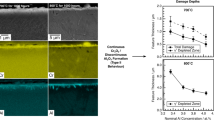Abstract
The nickel aluminide with boron alloy is being considered for elevated-temperature structural application in particular for jet turbine engine components. The alloy is attractive due to its ease of production, the low cost of its components, and its property advantages relative to superalloys. Therefore, if alloys based on Ni3Al are successfully developed, substantial increases in engine performance and efficiency may be realized.
The creep characteristics of an intermetallic Ni3Al alloy containing boron produced by hot isostatic pressing were investigated in the temperature range 800 to 900°C. Various heat treatments were used to produce different initial grain sizes of this alloy.
Parameters studied were steady state strain rate, time to fracture, ductility and Larson-Miller parameter. The stress exponent, activation energy for creep and grain size exponent were calculated.
It was found that by increasing the temperature of the heat treatment, the grain size increased. The results showed that the creep behaviour for this alloy improved as grain size increased. Furthermore, a comparison of the resulting creep data with data obtained from references is discussed.
Similar content being viewed by others
References
Westbrook, J.H.: Mechanical properties of intermetallic compounds. A Symp. Held During the 115th Meeting of the Electrochemical Soc. at Philadelphia, Pennsylvania, May 3–7, 1959, pp. 1-70.
Flinn, P.A.: Theory of deformation in superlattics. Trans. of Metall. Soc. of AIME, 218:145-154, 1960.
Liu, C.T., White, C.L., and Horton, J.A.: Effect of boron on grain-boundaries in Ni3Al. Acta Metall., 33:213-229, 1985.
Aoki, K. and Izumi, O.: Nippon Kinzaku Gakkaiski, 43:1190-1196, 1979.
Liu, C.T. and Kock, C.C.: Technical aspects of critical materials used by steel industry. National Bureau of Standards, Washington, DC, 1983, Vol. IIB.
Sikka, V.K.: Advances in processing techniques for nickel aluminide. Advanced Materials and Processing Techniques for Structural Applications, Paris, France, Sept. 7–9, 1987, pp. 295-305.
Grala, E.M.: Investigation of NiAl and Ni3Al. A Symp. held during the 115th meeting of the Electrochemical Soc. at Philadelphia, Pennsylvania, May 3–7, 1959, pp. 358-404.
Evans, R.W. and Wilshire, B.: Creep of metals and alloys. Preditive and Quantitives Metallurgy Series, D. McLear, Dotesio, Printers Ltd., England, 1985.
Langdon, T.G.: Deformation of polycrystals: Mechanisms and microstructures. Proc. 2nd Riso Int. Symp. on Metallurgy and Materials Science, N. Hansen et al., Riso National Laboratories, Roskilde, Denmark, 1981, pp. 45-54.
El-Magd, E.: Mechanisches Verhalten Metallischer Werkstoffe unter Berueksichtigung der Betriebsdingungen, Vorlesung des LFW, RWTH Aachen, 1989.
Stoloff, N.S.: Ordered for high temperature applications. Mat. Res. Soc. Symp. Proc., 39:3-27, 1985.
Destefani, J.D.: Advances in intermetallics. Advanced Material & Processes, 2(89):37-41.
Author information
Authors and Affiliations
About this article
Cite this article
Hashem, A., Stover, D., Buchkremer, HP. et al. Influence of the Heat Treatments on Creep Behaviour of Nickel Aluminide with Boron. Advanced Performance Materials 4, 9–23 (1997). https://doi.org/10.1023/A:1008672831156
Issue Date:
DOI: https://doi.org/10.1023/A:1008672831156




